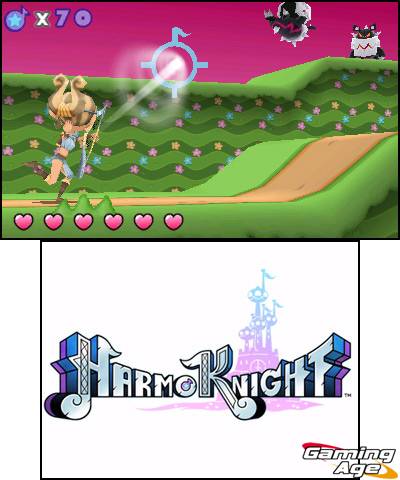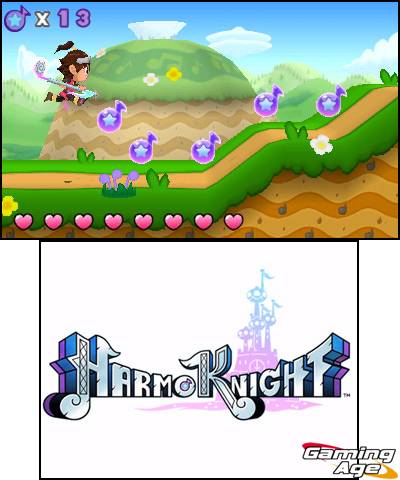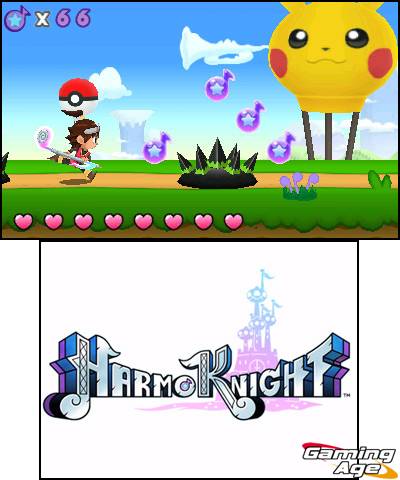Publisher: Nintendo
Developer: Game Freak
Medium: Digital
Players: 1
Online: No
ESRB: E
HarmoKnight is a pretty big departure from what most people would associate developer Game Freak with. But it?s a fresh change of pace for the longtime Pok?mon development house, and it?s great to see a viable, fun new IP emerge from them on the 3DS.
HarmoKnight is labeled as a rhythm platformer, taking cues from titles like Bit.Trip Runner, and tossing in enemies, combat, and an overworld map reminiscent of Super Mario World. You control a handful of colorful characters across the world of Melodia, attempting to combat the threat of the Noizoids, evil invaders that threaten the musical tranquility of the world.
There?s a whole lot of charm found in HarmoKnight in a variety of ways. The character designs are fantastic, with each character named after some sort of musical reference. The primary hero is Tempo, a traditional mute protagonist at first tasked with delivering a magical staff, but transitioning into unassuming guy saving the world quickly enough.
 Other characters provide some limited support, like the bow and arrow wielding Lyra, or the drum bashing Tyko, complete with cymbal clashing sidekick monkey Cymbi. HarmoKnight revels in its musical trappings at every twist and turn, and the visuals make excellent use of the 3D effect, transitioning from 2D side-scrolling sequences into various 3D camera angles when the action calls for it.
Other characters provide some limited support, like the bow and arrow wielding Lyra, or the drum bashing Tyko, complete with cymbal clashing sidekick monkey Cymbi. HarmoKnight revels in its musical trappings at every twist and turn, and the visuals make excellent use of the 3D effect, transitioning from 2D side-scrolling sequences into various 3D camera angles when the action calls for it.
It?s also a remarkably difficult game, which might seem at odds with the cutesy designs but ends up being a refreshing change of pace from most rhythm focused titles. The difficulty begins to spike with the first boss encounter, but there?s plenty of challenging run of the mill stages across the 7 worlds that make up the primary story. There are also additional challenges to take on in the form of bonus missions, with some nods back to Game Freak?s most well-known franchise, and some post-game content to explore after the credits roll.
While the majority of the game is comprised of side-scrolling stages where Tempo and others are on auto-run, there?s a fair amount of variety in how these stages are tackled or presented. The primary focus here is on attacking and dodging enemies and obstacles, using a combination of face buttons pressed in time with the music. For most encounters you?ll time your attacks to knock enemies out of the way, which will earn you musical notes that tally up at the end of the stage.
 Notes are also freely scattered about, so you can jump around to collect as many as possible. Once a stage ends and your total note count is tallied, and you?ll be awarded a medal, which typically earns a Royal Note. Royal Notes are used to unlock paths on the overworld map, but there are not a lot of points where they become necessary, and honestly this feels like the least thought out concept featured in HarmoKnight.
Notes are also freely scattered about, so you can jump around to collect as many as possible. Once a stage ends and your total note count is tallied, and you?ll be awarded a medal, which typically earns a Royal Note. Royal Notes are used to unlock paths on the overworld map, but there are not a lot of points where they become necessary, and honestly this feels like the least thought out concept featured in HarmoKnight.
The variety comes from the introduction of other characters mentioned above, who handle stage traversal and enemy encounters in different ways. When playing as Lyra the camera will swing around slightly behind her back, allowing you to line up shots at the background, which populates with enemies as you advance forward. You?ll be given crosshairs to assist with targeting, and given a dodge function to avoid incoming shots.
Tyko and Cymbi, on the other hand, are larger and more powerful, taking on bigger enemies when they?re brought into battle. Cymbi stands atop the shoulders of Tyko, giving you what equates to two combat lanes to take down enemies from. Again, crosshairs are given to help you line up attacks better with the zoomed in perspective given, but both characters help introduce some variety to the more standard sections that Tempo?s gameplay provides.
 Boss encounters usually take on a number of unique mechanics, giving you not only face button prompts to contend with, but directional prompts as well. They also end up being the hardest thing about the game. I can?t even tell you how many times I restarted a few of these encounters, but as I continued to press on, I found myself growing more and more accustomed to the patterns. It?s definitely structured in a way that you?re almost guaranteed to improve with each attempt, making the difficulty curve not as severe as it first appears.
Boss encounters usually take on a number of unique mechanics, giving you not only face button prompts to contend with, but directional prompts as well. They also end up being the hardest thing about the game. I can?t even tell you how many times I restarted a few of these encounters, but as I continued to press on, I found myself growing more and more accustomed to the patterns. It?s definitely structured in a way that you?re almost guaranteed to improve with each attempt, making the difficulty curve not as severe as it first appears.
The only thing that didn?t set my world on fire with HarmoKnight was the music. It?s not awful, but for some reason I found little that was memorable with the music selections. There?s some great variety from one world to the next, most of which are themed around particular musical styles, like the Caribbean/Beach themed calypso tunes found in World 3, the Rock/Drum heavy beats of World 2, and even a Metal infused world you?ll encounter later on. But I couldn?t recall a single track once I finished the game, with nothing really sticking in my head that I would immediately associate with HarmoKnight if I heard it elsewhere. And considering this is a game that?s all about music, it?s somewhat disappointing that the actual music isn?t more memorable.
But still, the gameplay and unique take on what we?ve come to expect from rhythm focused games is well worth the asking price. There?s a hefty amount of content in place for your money, and it?s easily one of the better eShop offerings I?ve had a chance to check out in recent months. And even if you?re not a fan of Pok?mon, don?t let the Game Freak hype scare you away here, there?s absolutely nothing comparable between the two IP?s other than some creature design similarities. It?s a wholly unique attempt at bringing something new and interesting to the handheld market, and for the most part it works really, really well.

